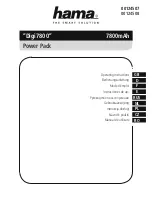
21
BASIC OPERATION
- The blade cuts on a continuous down-stroke. Never start the saw with the workpiece in contact with
the saw blade.
- With both hands, firmly hold the workpiece down on the table, and feed it slowly towards the blade,
putting only light pressure on it, and keeping your hands away from the blade.
- Keep your fingers away from the blade. Use a push stick whenever working close to the blade.
- For best results the blade must be sharp. A dull blade will not cut correctly, especially when straight
cutting, and causes excess pressure to be applied on the rear guide bearings.
- Select the right blade for the job, depending on the thickness of the wood and the cut to be made.
The thinner and harder the wood, the finer the teeth of the blade should be. Use a fine tooth blade for
cutting
sharp curves.
- The machine is especially suited for cutting curves, but will also make straight cuts. When cutting,
follow the design marked out by pushing and turning the workpiece evenly into the blade.
- Do not attempt to turn the workpiece without pushing it, as this may cause the workpiece to get
stuck, or bend the blade. For straight cuts, use the fence provided to feed the workpiece along the
blade slowly and in a straight line. Use a miter gauge for cross-cut or angle cutting.
- See page 6 for more operation information.
FIG. 42
Pivot the
Workpiece
Against
the
Re-saw
Bar
FIG. 43
OPERATION
ON/OFF SWITCH
To operate the saw, Press the round “ON” button in
to its full depth to turn the saw on. There should be a
‘click’ to indicate the ‘on’ contact is made.
Once work is finished, hit the safety paddle switch
marked “STOP” to turn the saw off. FIG. 42.
RE-SAWING
A re-saw guide bar is supplied to help correct any blade
wandering during certain re-sawing operations.
For re-sawing, attach the re-saw bar to the slot on the
fence. Position the re-saw bar so that it is aligned with
the front of the blade. Draw a reference line down the
workpiece. Use the bar as a pivot point, angling the
wood left or right while against the bar, to follow the line
through the cut. FIG. 43.
Note:
The re-saw bar is not needed for all re-saw
operations. Proper blade tension and selection, as well
as proper guide set up, will allow re-sawing flat stock
against the fence without the use of the re-saw bar.
ON
OFF
Summary of Contents for 10-342
Page 24: ...24 TROUBLESHOOTING...
Page 39: ...39 WARRANTY...
















































